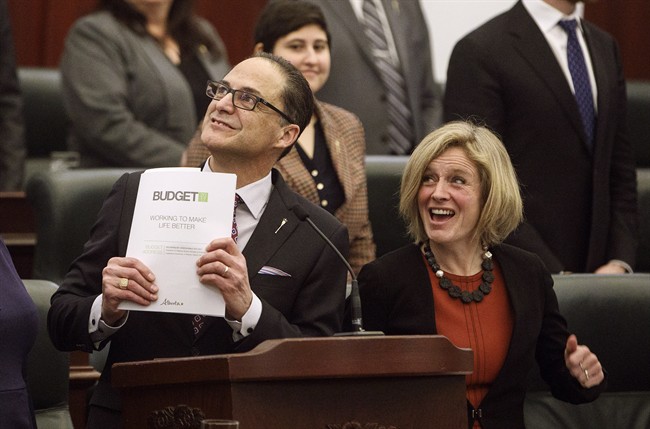It may seem curious to an outsider that even though Alberta’s economy has been battered and bruised over the last two years it would have the “weakest budget outlook among all provinces.” It can’t really be that bad, can it? After all, other provinces have gone through economic downturns, and Alberta still has numerous advantages.

For all the change that has come with the NDP displacing the decades-old Tory dynasty, there remains one constant in Alberta politics: governments wishing to have their cake and eat it, too.
It’s rather untenable for most governments to try to maintain high levels of spending and low levels of taxation, but when the resource revenue is pouring in, it’s quite easy — and awfully tempting — for Alberta governments to get away with it. Mind you, given the decade or so of consecutive deficits racked up by Alberta governments, it’s not quite as easy as it used to be.
So while the NDP did not create this situation, they have succumbed to the same old ways of addressing it: which is, to not address it at all.
For all their talk of “getting off the royalty roller coaster,” the NDP’s plan to someday, maybe balance Alberta’s budget remains almost exclusively dependent on that roller coaster once again coming to the rescue.
- Businesses warn of product shortages, rising costs due to possible postal strike
- Former CFL commissioner joins Northern Super League as board chair
- Wolf thrilled with Calgary Flames’ inspired start in 3-1 win over Los Angeles Kings
- Calgary Flames forward Anthony Mantha to undergo season-ending knee surgery
Unfortunately, for the Alberta government — and by extension, Alberta taxpayers — this is not going unnoticed. This past week, Alberta was hit with yet another credit downgrade, which came just a day after Finance Minister Joe Ceci was boasting of some good economic news in his second quarter fiscal update.
As much as the government would like to remind us of how the economy is starting to turn around, it only underscores the fact that the budget deficit looms as large as ever, and we have little in the way of a plan to address it. And in the meantime, a worsening credit rating can only lead to higher borrowing costs.

Get breaking National news
Governments probably get too much blame and too much credit for how the economy is performing. Alberta’s economy was eventually going to recover, despite those who thought that was an impossibility so long as the NDP remained in power. But the large and persistent deficits are directly attributable to the choices made by the NDP.
As DBRS Limited notes in their credit downgrade statement, the government “has yet to demonstrate any real willingness to address the weakest budget outlook among all provinces,” and that “the plan to return to balance relies on a recovery in resource revenues.” An improving economy does not change any of that.
WATCH BELOW:
When asked about the credit downgrade, Ceci devoted most of his responses to UCP leader Jason Kenney and the purported horror of whatever deep cuts the opposition might have in mind. But as University of Calgary economist Trevor Tombe has noted, dramatic cuts aren’t necessary to address the problem, and that, in fact, the final Tory budget would have put Alberta much further ahead when it comes to reducing the reliance on resource revenues.
But if the NDP believe that provincial spending is as low as it can possibly go, then the honest approach would be to look at revenue and find ways of paying for it all. Ceci, though, this week again rejected the idea of a provincial sales tax, and they have no inclination to use carbon tax revenue for this purpose, either.
So the plan remains the same: fingers crossed and hope for the best.
Unfortunately, in the meantime, that means adding more debt, a higher debt-to-GDP ratio, and higher borrowing costs. And the NDP have no one to blame but themselves.
Rob Breakenridge is host of “Afternoons with Rob Breakenridge” on Calgary’s NewsTalk 770 and a commentator for Global News.

















Comments